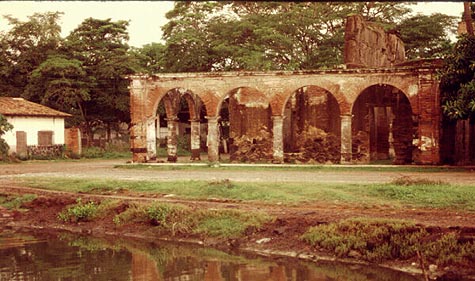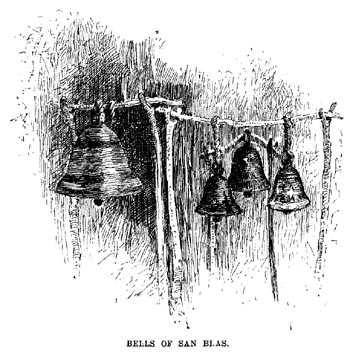Several famous writers wrote about Mexico despite having no direct geographic experience of the country. In an earlier post, we looked at the case of Jules Verne. This time, we look at Henry Wadsworth Longfellow.
There is some sound historical geography in the famous poem The Bells of San Blas, yet author Henry Wadsworth Longfellow had never ever visited the town.
The San Blas referred to in the poem is on the Pacific coast, in the state of Nayarit. It is a small town with several good hotels and restaurants, and a birding “hot spot”. The variety of habitats around the town, ranging from sandy beaches and luxuriant mangroves to palm plantations and tropical swamps, have attracted more than 500 different bird species, or about half of all the bird species known in Mexico.
The town’s economy was not always geared to tourism. For more than a century, San Blas, founded in 1768, functioned as an important port and boat-building center. The vessels built in San Blas included those used by Junípero Serra to establish missions in California. To ensure that taxes were paid on imports, an imposing customs house was built on the shore. To guarantee safe passage, a church dedicated to “Our Lady of the Sailor’s Rosary” stands atop the steep-sided Cerro de San Basilio which overlooks the town. In the church hung the famous bronze bells.

The former Customs House of San Blas in the evening light, 1989. Photo: Tony Burton. All rights reserved.
Time conspired against the port of San Blas. The harbor silted up, the coastline gradually inched its way further west. Over the years, other ports such as Acapulco and Mazatlan became more important. San Blas declined. The customs house and church were abandoned, transformed from bustling buildings into evocative ruins. By the end of the 19th century, the port was very much a “has been”.
In March, 1882, far away from Mexico, in Cambridge, Massachusetts, the American poet Henry Wadsworth Longfellow (best known for Paul Revere’s Ride, The Song of Hiawatha, and Evangeline) lay on his deathbed. Longfellow, born in 1807, was a prolific poet and accomplished linguist. After a long and illustrious career, which included teaching at Harvard College, his life was now drawing to a close, even as the distant port of San Blas was falling into disuse.
By a happy coincidence, the March 1882 issue of Harper’s new monthly magazine (Volume 64, Issue 382) contained an article by William Henry Bishop, entitled “Typical Journeys and Country Life in Mexico”. Bishop’s article described several Pacific coast ports, including San Blas:
“Acapulco has the most complete and charming harbor, and an old fort dismantled by the French, of the order of Morro Castle. Manzanillo is a small strip of a place on the beach, built of wood, with quite an American look. The volcano of Colima appears inland, with a light cloud of smoke above it. San Blas, larger, but still hardly more than an extensive thatched village, has, on a bluff beside it, the ruins of a once more substantial San Blas. Old bronze bells brought down from it have been mounted in rude frames a few feet high to serve the purpose of the present poor church, which is without a belfry, and this is called in irony ‘the Tower of San Blas.'”
The article was accompanied by an illustration showing four bells swinging from a rickety wooden frame.
The article and its accompanying illustration prompted Longfellow to write what would prove to be his last poem, entitled The Bells of San Blas.
Like the port at that time, Longfellow saw the bells as relics from a byegone age:
They are a voice of the Past,
Of an age that is fading fast,
Of a power austere and grand;
When the flag of Spain unfurled
Its folds o’er this western world,
And the Priest was lord of the land.The chapel that once looked down
On the little seaport town
Has crumbled into the dust;
And on oaken beams below
The bells swing to and fro,
And are green with mould and rust.
Several days later, Longfellow penned the last stanza, with a suggestion of optimism for the future:
O Bells of San Blas, in vain
Ye call back the Past again!
The Past is deaf to your prayer;
Out of the shadows of night
The world rolls into light;
It is daybreak everywhere.
On March 24, Longfellow, who had never had the good fortune to visit San Blas in person, passed away.
Should you visit San Blas today, spare a thought for this genius of a poet who was able to capture so eloquently the declining fortunes of this once-great port.
What further stanzas remain to be written in the story of San Blas, now revived by its important naval base and ornithological tourism?
Original article on MexConnect.
The development of Mexico’s transportation system is discussed in chapter 17 of Geo-Mexico: the geography and dynamics of modern Mexico. Ask your library to buy a copy of this handy reference guide to all aspects of Mexico’s geography today! Better yet, order your own copy…
3 Responses to “The Bells of San Blas, a poem about the historical geography of a port in Nayarit, Mexico”
Sorry, the comment form is closed at this time.

Thankyou for the info. We recently visited San Blas, on a day trip from our vacation home in Rincon de Guayabitos. Our tour guide was informative, but with so much history, I felt it necessary to search further. I am enjoying our holiday all over again!
San Blas…. One of the only pacific beach towns that hasn’t changed very much in the last 35 years. This is do in no small part to the voracious sand flies that inhabit the beaches at dusk and dawn. That’s what you get for living next to a large mangrove swamp. Lovely birding it the area and a good jumping off place for visiting Mexcaltitan. San Blas is a fun place for exploring the surrounding nature but a bad place to watch sunset on the beach. If your going birding and looking for a ride in the mangroves. Look up “Don Chencho” … Nice guy and knows where to find what your looking for. He’s somewhere under the bridge over the river as you enter town.
Thanks for the recommendation for Don Chencho.Hope I can get back to San Blas sometime before too long, TB